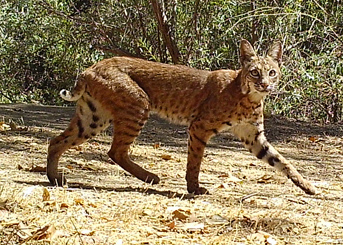The Habitat Authority is a local government agency, and is qualified to accept tax-deductible charitable donations including monetary and real property. Donations such as these contribute to the purpose of the agency and provide tax benefits for the giver.
Checks can be made payable to:
Puente Hills Habitat Preservation Authority
7333 Greenleaf Avenue, First Floor
Whittier, California 90602
Lands donated to the Habitat Authority include:

In February of 1997, Benson Ford Jr. generously donated 8 acres of vacant land located in Hacienda Heights. Along with this donation was a monetary gift of $20,000 to assist with the clean up of the former home site. Since its acquisition, the Habitat Authority has revegetated the site with native plants, and regularly has it patrolled by rangers to keep it secure and safe for the nearby neighborhood. This property has a beautiful vista and is a regular resting spot for recreationists using the Los Angeles County Schabarum (Skyline) Regional Trail.
In December of 2002, Janis Grimont generously donated 5 acres of vacant land located in La Habra Heights. Her donation was made first to the Wildlife Corridor Conservation Authority, another local government joint powers authority, and transferred to the Habitat Authority in a simultaneous chain transaction. The land is located in the middle of a very narrow section of a wildlife corridor that extends from the 605 Freeway in the west, all of the way to the Santa Ana Mountains in the east. One benefit from this land linkage is that it helps to ensure a continuous pathway for migrating wildlife.
Please see Tax Consequences tab for more information.
Appreciated property is property which has a low adjusted basis (cost, plus improvements, minus deprecation), but a higher fair market value. When most people give real property to the Habitat Authority, they want a deduction equal to the fair market value of the real property donated, as opposed to the (presumable) lower adjusted basis of the property. This allows the donor to deduct the amount of the gain on the property (difference between fair market value and adjusted basis) without paying taxes on the gain.
How much of tax benefit you receive and how quickly you can realize this benefit often depends on the nature of your property. If the sale of your contributed property would have produced ordinary income or short term capital gain (as opposed to long term capital gain), the fair market value of your property must be reduced by the amount of ordinary income or short term capital gain (See CCH Federal Tax Service Section A:17.100 and IRC Section 170). If the IRS decides that you’re holding property as an investment, then the capital gain tax would apply and, subject to other limitations, the full fair market value of the contribution could be used in calculating your deduction. If, on the other hand, the IRS considered your property inventory in a trade or business (i.e. real estate lots for resale by a real estate developer), then only the adjusted basis can be used to calculate the deduction. This capital gain/ordinary income determinations depends on many factors, but the characterization of the property as a capital asset held for a sufficient period to constitute a long term capital gain is generally very important to maximizing the tax value of any form of charitable donation of appreciated property.
It is also important to note that there are different rules for gifts of tangible personal property when the donor’s use of the property is unrelated to its tax-exempt purposes or functions. Also matters become more complicated if the transferred property is subject to a mortgage or deed of trust.
There are limitations to the amount you can deduct in the first year. These depend on the type of donor category which you fall into, and the type of property donated. Because the Habitat Authority is considered “50% charities” (as opposed to a non-broadly supported private charity called a “30% charity), an individual donor is limited to deducting in the first year an amount equal to 50% of the donor’s adjusted gross income, without regard to net operating loss carrybacks. The balance of the unused deductions may be carried forward for up to the next five years. However, if the donated property has appreciated in value and no election is made to pay the income taxes as if the property were sold in the year of donation, then the limitation of the first year deduction of this appreciated property is 30% of the donor’s adjusted gross income, rather than the 50%. (See CCH Section A:17.100 et seq.)
One should keep in mind that the excess over the allowed percentage deduction in the first year is then deductible in the following year up to the applicable percentage of gross income limitation. Excess deductions can be rolled over for up to five years. Thus the timing of the tax deductions will depend on the donor’s adjusted gross income. Further, it is only very large donations, in relationship to the donor’s adjusted gross income, where a portion is spread out over up to five years.
[ ] SIDEBAR EXAMPLE If a person donated $70,000 in appreciated property to the Habitat Authority (which means the 30% limit applied) and the donor’s adjusted gross income is $100,000 every year, the donor would be able to deduct $30,000 the first year (30% of $100,000), $30,000 the second year (30% of $100,000) and $10,000 the third year (remainder of value of gift, but not in excess of 30% of the adjusted gross income). (See also example in CCH Section A:17.126[1]).
If a donated parcel of real property is owned by a limited partnership, the it is possible that the various general and/or limited partners may be able to separately donate their partnership interests, rather than donating one single parcel of real property, or alternatively, the partnership makes the contribution with each partner taking its distributive share of the deduction (See IRC §702). This would require review of the terms of the partnership agreement. The partnership interest contributed will likely have the same characteristics (ordinary income or long term capital gain) as does the underlying partnership asset. (See CCH Section H:16.40)
While husband and wife filing joint returns are aggregated for the first year deduction limitations, other partnership relationships would have to be examined to see whether each partner who contributes a partnership interest is entitled to his or her own deduction, or whether because of the closeness of the partnerships all donations of partnership interest which would effectively transfer the entire interest in the real property need to be aggregated.
It should be noted that if one of the donors is a corporation, that IRC §170(b)(2) limits yearly donations from corporations to 10% of its taxable income computed without regard to certain items. Excess donations can be carried over for five years, subject to the yearly 10% limitation. If one of the limited partners is a corporation, the Habitat Authority might be able to purchase the corporation’s interest and have the individual provide most of the donation portion so as to maximize the deduction in the first year.
Rather than making an outright donation, it is possible to make a bargain sale to the Habitat Authority in which a portion of your property is sold at fair market value, while the remainder is donated. In this case, the gain from the sale portion is allocated proportionately to the total value (See CCH Sections A:17.140-A:17.145).
While giving or bargain selling portions of real property at different times is often done, it is sometimes more beneficial taxwise to donate the entire property at once. The total value of all small parcels separately donated may not equal the value of one larger lot given at one time. For instance, if there are 100 acres available, then a gift or bargain sale of 50 acres would be possible, assuming proper lot split rules were followed. If the donor wanted to give the other 50 acres to the Habitat Authority at a later date, there would have to be a separate valuation of the property. However, that valuation might indicate a lower value due to the reduced size of the donor’s holding.
There are several types of charitable remainder trusts, but one common form is the charitable remainder annuity trust. With such a trust, the donor transfers the property to an irrevocable trust and is paid a yearly amount of not less than five percent of the fair market value of the gift for the donor’s lifetime, or a fixed term of not in excess of twenty years, after which the donated property belongs to the Habitat Authority. The donor takes the yearly payments as income, but is permitted a current deduction equal to the present value of the remainder interest. The deduction is subject to the same percentage limitations on the sale of appreciated property (30% of adjusted gross income) as are other gift deductions. The actual amount of the deductions is calculated using present value tables provided by the IRS.




7333 Greenleaf Ave
First Floor, Whittier, CA 90602
© Puente Hills Habitat Preservation Authority. All Rights Reserved.